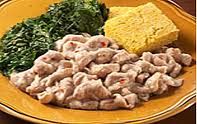What the Slaves Ate: Recollections of African American Foods and Foodways from the Slave Narratives, by By Herbert C. Covey, Dwight Eisnach
Chitlings/Chitterlings/Chitlins
From What the Slaves Ate: Recollections of African American Foods and Foodways, by Herbert C. Covey, Dwight Eisnach: As has been noted, virtually nothing was wasted on the plantation including intestines of hogs. Pork chitterlings, or chitlins, although associated with African Americans and made from the small intestines of pigs, were consumed by all in the South (Hiliard, 1972); Despite their origin and the fact that to prepare them requires great care and multiple cleanings of manure out of the intestines, resulting in a strong odor, chitlins were considered a delicacy by some southerners. Because of the odor during cleaning and cooking, chitlins traditionally were cooked outdoors at backyard hog killings in winter. After cleaning, slaves took the intestines and often dipped them in batter and then fried them until brown.
Initially, southern whites were not interested in eating chitlins. The narrative of Mr. Norris (MN) revealed how whites got the good parts but eventually possibly from slave influences, developed a taste for chitlins:
"And about our eatens, I forgot to tell you when we was talking about that. When we killed hogs, the white folks go all the good part, least they thought that, and we got the neck bones, and ears, and snoots, and tails, and feet, and the entrails; what they called chitlings (chitterlings). The white folks didn't eat any of that stuff, till the last years, when hard times begin to hit them and thy seen how we fared, not you cant get to the counters to get them things for the whites."
Slaves became adept at using the ears, or maws, feet, and neck bones of pigs in other dishes because of the West African tradition of cooking all edible parts of plants and animals. This kind of food efficiency helped the slaves survive. Because chiterlings were considered "slave food," some African Americans today consider them demeaning, or offensive, and refuse to eat them. Others do not eat chitlins due to their odor and care required in their cooking (Stradley 2004). Lulu Scott (IN) viewed the as a common food at Christmas time:
"Christmas time we'd hang up our stockings and get a glass-headed doll. And we'd have black cake, and plum pudding. Black cake is like fruit cake except it didn't have no raisins and nothing in it. We had turkey, chitling and everything cook enough to last a week."
Finally, Annie Stephenson (NC) described the availability of chitlins during hog killing time and how slaves were permitted to eat the "guts' of hogs almost immediately following their slaughter:
"They had plenty hogs and that was a time when they killed them. Dring up the fat for lard, trimming and salting the meat and chitlins. The hog guts was called chitlins. Slavs was allowed to eat meats as soon as the hogs was gutted. They was allowed to boil some lean parts of the meat and eat it a the killing."
During the Antebellum period, pork was the most important meat on all southern tables. Archaeological evidence indicates that pork was the most common meats eaten by slaves (Samford 1996). There were many reasons why pork was the most common an popular meat in the South, including that hogs were efficient in converting corn to meat, were ready to butcher in the fall or winter, ate virtually anything (such as vines, acorns, and so on(, and could be penned. Pork was smoked or salted for storage (Taylor 1982), Moore (1989) found several references to the abundance of pork in eighteenth-century plantation Virginia. (source: What the Slaves Ate: Recollections of African American Foods and Foodways, by Herbert C. Covey, Dwight Eisnach)





No comments:
Post a Comment